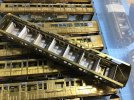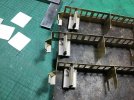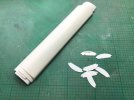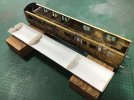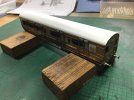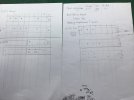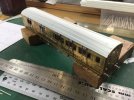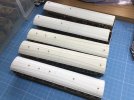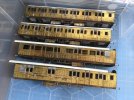Heather Kay
Western Thunderer
Lumme, doesn’t time go quickly?
No piccies, sorry. Just a progress report.
There hasn’t been much.

Actually, there has been some. Discussions about how to get the coaches painted has led to the notion the paint shop might as well assemble the things rather than try and ship them back down south to me. It’s a right pain living this side of London when most clients are the other side. I’m happy with that solution, as it makes logistics simpler all round (apologies for the buzzwords!).
So, my aim now is to get the models as sub-assemblies progressed as far as possible so they can be nailed together once the bodies are decorated.
Today, then, saw me gluing in the false floors, and opening up the holes for the buffers. I have to say the buffer castings are shocking. I hope I have picked the best ones for the brake ends. The ones in the middle of the consists aren’t seen all that clearly. I hadn’t fitted the buffers before, because being whitemetal with the consistency of chilled butter they are very likely to be knocked and snapped off. I just have to be even more careful now.
I also experimented with interior fittings, which proved successful. Another step along the road.
No piccies, sorry. Just a progress report.
There hasn’t been much.

Actually, there has been some. Discussions about how to get the coaches painted has led to the notion the paint shop might as well assemble the things rather than try and ship them back down south to me. It’s a right pain living this side of London when most clients are the other side. I’m happy with that solution, as it makes logistics simpler all round (apologies for the buzzwords!).
So, my aim now is to get the models as sub-assemblies progressed as far as possible so they can be nailed together once the bodies are decorated.
Today, then, saw me gluing in the false floors, and opening up the holes for the buffers. I have to say the buffer castings are shocking. I hope I have picked the best ones for the brake ends. The ones in the middle of the consists aren’t seen all that clearly. I hadn’t fitted the buffers before, because being whitemetal with the consistency of chilled butter they are very likely to be knocked and snapped off. I just have to be even more careful now.
I also experimented with interior fittings, which proved successful. Another step along the road.

